Six Characteristics of Highly Effective School Leadership
Rethinking high school means rethinking leadership. Preparing students with the skills they’ll need to succeed…

Rethinking high school means rethinking leadership. Preparing students with the skills they’ll need to succeed after graduating—like collaboration, original thinking, and lifelong learning—takes creativity and commitment to bold change. School leaders create the conditions under which this change is possible. As Sean McClung, XQ’s head of school success, explains, “School leaders are doing change management with a lot of people in a complex organization, community, with a lot of stakeholders.”
What does it mean to be an effective leader in this context? What traits do leaders need to empower their communities to reach their full potential? Drawing from our XQ Design Principles—pillars for rethinking what high school can be—as well as examples of leaders from XQ schools, we came up with these six characteristics that highly effective school leadership tends to share.

1. School leaders need to be passionate with an ambitious vision for what high school can be.
High schools succeed when every member of the community—from students, to staff, to community partners—is united in a strong mission and culture. The best school leaders serve as the keepers of that shared mission. These leaders embody an infectious passion, coherently articulate the school’s goals, and keep everyone focused on what matters most: serving students.
That’s not easy in school systems, which can be notoriously bureaucratic. But McClung explains, “The best leaders are passionate, driven, and committed. They can exist in a system of limits, complexity, oversight, and compliance, and constantly see beyond it and look for ways to do amazing work.”
This passion and drive are especially critical when a school’s bold mission goes against the grain of traditional school practices. Trace Pickering, executive director and co-founder of Iowa BIG, an XQ school in Cedar Rapids, IA, learned this first-hand. Iowa BIG’s design is wildly ambitious: instead of learning through traditional classes and subjects, students learn through doing by taking on “initiatives” proposed by community partners.
For Pickering, part of sustaining this mission means serving as a keeper of the vision as doubts and challenges arise. “People wonder if the kids are ‘really learning,’” explains Pickering. “Of course, they assume that ‘learning’ is passing a test or temporarily memorizing the periodic table or the timeline for World War II.” Instead, at Iowa BIG, students learn through a competency-based approach: students progress through content based on their mastery of core, clearly defined skills, and knowledge, rather than time spent in seats. Competency-based education emphasizes actual student learning, shifting focus from more superficial measures like memorization or seat-time.
In moments of doubt, Pickering refocuses the narrative and champions the school’s approach. He points to the success of Iowa BIG in terms of increased student engagement and rearticulates the core mission of the school to transform learning. This approach has paid off. By sticking to its ambitious mission, Iowa BIG is changing the game for students: the school is a national model for transformative, student-centered education.
2. School leaders need to be asset-minded.
Part of being a great leader is bringing out the greatness in others. It is about sharing power and leadership to empower others to be their best. Highly effective school leaders see the strengths in the people around them and create opportunities for those strengths to flourish.
You can see this successful asset-mindedness in how school leaders support and empower teachers and staff. Highly effective leaders practice distributed leadership: instead of merely delegating tasks to teachers, leaders give teachers real power and ownership over crucial aspects of the school, like professional development or teacher mentoring.
Effective school leaders also extend this concept of leadership to students. To support youth voice and choice, school leaders empower students as stakeholders and changemakers in the school community.
Case in point: Elizabethton High School, an XQ school in Elizabethton, TN. When Elizabethton High received American Rescue Plan funding, school leaders sent out a survey to gather student input on how to invest the funds. The students wanted to expand their involvement. Students Maggie Cole and Morgan Guinn requested a meeting with their school principal and the district superintendent to discuss the rationale for students’ funding priorities.
Elizabethton school leaders embraced this opportunity for student perspective and power. They worked closely with Cole and Guinn to talk about how the district’s budget functions, and how the students’ ideas could be implemented. Ultimately, almost all student suggestions were adopted—including significant investment in mental health resources.
This project is a concrete example of how Elizabethton’s leaders upheld the mission of the school: to empower students as changemakers in their community. “This project was important because it speaks to our core values,” explains assistant principal Sheri Nelson. “It’s our goal to teach our students to be self-advocates, to be communicators. That’s the best way for us to meet their needs, so they can be successful in high school and beyond.”
3. School leaders should be accessible and engaged with the day-to-day work of the school.
When school leaders are present in the classroom, students take note. By making classroom visits and taking an interest in what students are doing, leaders demonstrate to students that their work matters. This promotes meaningful, engaged learning, where students feel seen and valued as learners.
Mary Ryerse, XQ’s managing director for school success, explains, “Young people need to see leaders working together to encourage learning. It’s not just about, ‘How did your choir performance or your basketball game go?’ It’s also, ‘What project are you working on meaningfully?’”
“Once they’ve established a relationship, the questions or engagement points with young people can be directly around their learning,” she adds. “Don’t underestimate the power of one or two reflective comments.”
The significance of these connections extends to the leaders as well. Chris Terrill, executive director at Crosstown High—an XQ school in Memphis, TN—shows what engagement with students looks like in action in a mutually caring school environment. When Terrill discovered that he suffered from high cholesterol, he took his problem straight to students. In collaboration with a partner from a local college of nursing, students created a video with a plan for Terrill to lower his cholesterol. The plan worked—Terrill’s health improved—and students also got to apply competencies to a project with meaningful results.
This example speaks to a larger culture at Crosstown, where students consistently connect their learning to real-world challenges. By getting involved in a student project, Terrill demonstrated to students how much their knowledge and learning can help others while also expanding their own knowledge.
4. School leaders should be innovative—not constrained by the status quo.
The best school leaders can translate big-picture goals to day-to-day reality, to ask: what structures need to change to transform learning and ensure student success? The most entrenched aspects of high school are often logistical. Highly effective leaders consider all elements of time, space, and technology when evaluating what needs to change to serve students. Decisions are then made that align with the school’s unified mission and culture.
Ryerse explains, “It all starts with a strong culture and clarity of a vision by the leader, and a willingness and tenacity in making sure that vision is realized in the day-to-day operations of the school. Strong leaders are willing to ask: do our beliefs show up in how we run our school—everything from the master calendar, to extracurriculars, to staffing and hiring?”
This vision must include everyone involved in the school community. One crucial example: how can a school most effectively use time to support teacher collaboration? Christopher Hanks, principal at Grand Rapids Public Museum School—an XQ school in Grand Rapids, MI—offers a framework for how to use time to support collaboration, with suggestions like:
- Identify the purpose or need, and clearly communicate tasks, timelines, and deliverables
- Create a schedule that supports the work
- Communicate with teachers, incorporating teachers’ insights into their own workflows and capacities, and expressing the constraints and imperatives you’re facing
This example shows that by innovating the structure of the day, leaders can maximize a school’s existing resources—in this case, the talents of teachers.
5. School leaders should be collaborative.
Learning does not take place in a vacuum. We’ve learned that some of the most powerful opportunities for student learning lie outside of school walls. Highly effective leadership recognizes how students can benefit from connecting with local businesses and resources, and build community partnerships into the structure of the school, thereby setting their students up for success.
At a structural level, leaders facilitate effective community collaborations through:
- Aligning partnerships with the school’s mission, culture, and values
- Seeking out partnerships that support students’ particular needs and learning goals
- Ensuring partnerships are mutually beneficial for both students and the community
Purdue Polytechnic High School (PPHS)—an XQ school in Indianapolis, IN—embodies how school leadership can build collaboration into the core design of high school. PPHS was founded to serve as an engine of social mobility, increasing the number of students from underrepresented backgrounds attending Purdue University each year. To do this, school leaders partnered with Purdue University, designing a curriculum aligned to Purdue University’s academic standards, and creating opportunities for students to pursue dual enrollment while in high school.
Leaders also built a school model that incorporates rigorous, mutually beneficial community partnerships into the curriculum. Students at PPHS learn through interdisciplinary project cycles designed by teachers and community partners. During each cycle, students address authentic challenges, researching, designing, and prototyping ideas to present to their industry partner—like partnering with the Indianapolis Zoo to increase conservation efforts. Through this model, students get the chance to build real-world skills and experience, and partners benefit from students’ work and creativity.
6. School leaders need to be relational—they should commit to building trust and connection at all levels of the school.
Learning is all about relationships, and that includes school leaders. Great leaders intentionally make themselves accessible to teachers and students, modeling caring, trusting relationships.
They take this ethos—that every student should feel known and supported by adults at school—and imbed it within the school’s design. XQ’s McClung explains, “You have to figure out how to multiply the number of quality interactions between different adults, mentors, and role models in the community. How you design that, and how you deploy the people on your team, has a big impact on the kinds of relationships that young people are going to have in the school.”
Círculos—an XQ school in Santa Ana, CA—is a prime example. In a district where 80 percent of students are English Language Learners and 100 percent of students participate in the free and reduced lunch program, Círculos’ mission is to provide students with the social capital and connections they’ll need to be successful after graduation.
Círculos’ leaders do this by investing in relationships at a structural level. Círculos students participate in daily circles, where they have an opportunity to share their goals, successes, and challenges. These circles provide opportunities for students to form meaningful connections with peers and with staff, and to feel personally seen and known as both students and people. Círculos leaders also expand this idea of circles to involve the community outside of school, connecting students with mentors and community leaders across the city.
School founder Jessica Salcedo explained how these structures support relationships. “Our school is all about making connections,” she says.”We do that through circles, our signature pedagogy. Circles provide an intentional space for all students to be seen and heard—to develop their voices and identity in relationship to each other, their community, and their learning.”
Salcedo’s emphasis on connections and community illustrates the core of effective leadership: to facilitate relationships that support learning, and to empower everyone to be their best. While no two leaders are exactly alike, all effective leaders put their communities first—creating the conditions for their schools to thrive.
To read more about how to make these connections as a school leader, check out our deep dives into XQ Design Principles and see our XQ Learner Outcomes.









